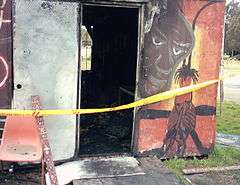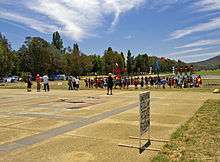Aboriginal Tent Embassy
The Aboriginal Tent Embassy is a semi-permanent assemblage where residing activists claim to represent the political rights of Aboriginal Australians. It is made up of signs and tents on the lawn opposite Old Parliament House in Canberra, the Australian capital. It is not considered an official embassy by the Australian Government.
History
On 26 January 1972, four Aboriginal men (Michael Anderson, Billy Craigie, Tony Coorey and Bertie Williams) arrived in Canberra from Sydney to establish the Aboriginal Embassy by planting a beach umbrella on the lawn in front of Parliament House (now Old Parliament House).[1] The Embassy was established in response to the McMahon Coalition Government's refusal to recognise Aboriginal land rights. McMahon instead favoured a new general purpose lease for Aboriginal people which would be conditional upon their 'intention and ability to make reasonable economic and social use of land' and it would exclude all rights they had to minerals and forestry.
The beach umbrella was soon replaced by several tents and Aboriginal people and non-indigenous supporters came from all parts of Australia to join the protest. During the first six months of its life in 1972 the Embassy succeeded in uniting Aboriginal people throughout Australia in demanding uniform national land rights and mobilised widespread non-indigenous support for their struggle. Other people associated with the Embassy demonstration in 1972 include Paul Coe, Gary Foley, Chicka Dixon, Gary Williams, John Newfong, Sam Watson, Pearl Gibbs, Roberta Sykes, Alana Doolan, Cheryl Buchannan, Pat Eatock, Kevin Gilbert, Denis Walker, Isobelle Coe and Shirley Smith.[2]
In February 1972 the Aboriginal Tent Embassy presented a list of demands to Parliament:
- Control of the Northern Territory as a State within the Commonwealth of Australia; the parliament in the Northern Territory to be predominantly Aboriginal with title and mining rights to all land within the Territory.
- Legal title and mining rights to all other presently existing reserve lands and settlements throughout Australia.
- The preservation of all sacred sites throughout Australia.
- Legal title and mining rights to areas in and around all Australian capital cities.
- Compensation money for lands not returnable to take the form of a down-payment of six billion dollars and an annual percentage of the gross national income.[3]
The demands were rejected, and in July 1972, following an amendment to the relevant ordinance, police moved in, removed the tents and arrested eight people.
In October 1973, around 70 Aboriginal protesters staged a sit-in on the steps of Parliament House and the Tent Embassy was re-established. The sit-in ended when Labor Prime Minister Gough Whitlam agreed to meet with protesters.
In May 1974 the embassy was destroyed in a storm but was re-established in October.
In February 1975 Aboriginal activist Charles Perkins negotiated the "temporary" removal of the embassy with the Government, pending Government action on land rights. The Fraser Government subsequently enacted the Aboriginal Land Rights Act in 1976, after its drafting by the Whitlam Labor Government in 1975.
In March 1976, the Aboriginal Embassy was established in a house in the nearby Canberra suburb of Red Hill; however, this closed in 1977.
For a short period in 1979, the embassy was re-established as the "National Aboriginal Government" on Capital Hill, site of the proposed new Parliament House.
On the twentieth anniversary of its founding, the Aboriginal Tent Embassy was re-established on the lawns of Old Parliament House. Despite being a continual source of controversy, with many calls for its removal, it has existed on the site since that time.

As well as political pressure, the Aboriginal Tent Embassy has also been under attack from criminal elements, having been fire bombed on a number of occasions.
Some local Aboriginal Ngunnawal people have also called for the eviction of residents of the tent embassy.[4]
Despite this, in 1995 the site of the Tent Embassy was added to the Australian Register of the National Estate as the only Aboriginal site in Australia that is recognised nationally as a site representing political struggle for all Aboriginal and Torres Strait Islander people.[5]
In the leadup to the 2000 Sydney Olympics, Isobell Coe from the Wiradjuri Nation set up a Peace Camp and combined ashes from Canberra's sacred fire to the fire at Victoria Park in Camperdown to promote reconciliation.[6] This sacred fire was originally made by Kevin Buzzacott and lit by Wiradjuri man Paul Coe at the Canberra Tent Embassy in 1998.[7]
Issues
There have been a number of suspicious fires at the site, with the most devastating being the loss of 31 years of records when the container burnt down in June 2003.[8]
The future of the Aboriginal Tent Embassy

In August 2005, the Federal Government announced a review into Canberra's Aboriginal tent embassy. They consulted with the Aboriginal communities around Australia to determine what shape the tent embassy should take in future.[9] The group was headed by Minister Jim Lloyd and contained a number of Aboriginal Elders from around Australia. Professional mediators Callum Campbell and Tom Stodulka were called in to facilitate the process and consult with indigenous and non-indigenous Australians, to obtain and represent their views. This organisation was called Mutual Mediations. They reached a decision on the Embassy's future early in December 2005.
Australia Day 2012 protests
On 26 January 2012 Prime Minister Julia Gillard and Opposition Leader Tony Abbott were attending an event at the Lobby Restaurant when the site was surrounded by protesters who had arrived from the nearby Tent Embassy.[10] The protesters were angry at comments Abbott had supposedly made in an ABC interview that morning. Gillard and Abbott were hastily escorted from the restaurant under the protection of police officers and during the scramble Gillard lost one of her shoes, which was collected by protesters although later returned to her.[11][12][13][14][15]
See also
References
- ↑ "Aboriginal Tent Embassy: Icon or Eyesore?". Parliament of Australia. Canberra: Parliamentary Library. 4 April 2000. Retrieved 31 May 2010.
- ↑ Australia Day under a beach umbrella, Collaborating for Indigenous Rights, National Museum of Australia Archived 17 March 2012 at the Wayback Machine.
- ↑ "The Bush Capital « The Global Dispatches". www.theglobaldispatches.com. Retrieved 13 April 2018.
- ↑ "The Future of the Tent Embassy". Message Stick. Australian Broadcasting Corporation. 25 November 2005. Archived from the original on 27 April 2016. Retrieved 31 May 2010.
- ↑ "Aboriginal Embassy Site, King George Tce, Parkes, ACT, Australia (Place ID 18843)". Australian Heritage Database. Department of the Environment. Retrieved 31 May 2010.
- ↑ http://www.roninfilms.com.au/feature/416/fire-of-land.html Documentary 'Fire of the Land' (2002)
- ↑ "Archived copy". Archived from the original on 13 May 2013. Retrieved 20 February 2014.
- ↑ Yaxley, Louise (19 June 2003). "Aboriginal Tent Embassy burnt out". The World Today. Australian Broadcasting Corporation. Retrieved 31 May 2010.
- ↑ Truscott, Marilyn. "Reconciling two settings: responding to threats to social and scenic heritage values" (PDF). International Council on Monuments and Sites. Retrieved 31 May 2010.
- ↑ Jessica Wright; Dan Harrison; Dylan Welch (27 January 2012). "Australia Day Turns Ugly". The Sydney Morning Herald. Retrieved 27 January 2012.
- ↑ "Aboriginal protesters overreacted to Tony Abbott, says Warren Mundine". Australian Associated Press. 27 January 2012.
- ↑ "Riot police rescue Gillard, Abbott from protesters". abc.net.au. 26 January 2012. Retrieved 13 April 2018.
- ↑ Packham, Ben; Vasek, Lanai (27 January 2012). "Gillard, Abbott escorted under guard amid Aboriginal Tent Embassy protest". The Australian.
- ↑ http://www.heraldsun.com.au/news/more-news/police-called-after-gillard-and-abbott-trapped-by-protesters-in-canberra/story-fn7x8me2-1226254409434
- ↑ Medhora, Shalailah (27 January 2012). "Gillard's shoe returned after protest". SBS. Retrieved 7 April 2014.
Further reading
- Gary Foley (2001) Black Power in Redfern: 1968–1972
- Robinson, Scott (1994) The Aboriginal Embassy: An Account of the Protests of 1972', Aboriginal History 18(1): 49–63.
- Lothian, Kathy (2007) ‘Moving Blackwards: Black Power and the Aboriginal Tent Embassy’ in Ingereth Macfarlane & Mark Hannah (eds) Transgressions: Critical Australian Indigenous Histories. Acton, ACT: ANU E-Press.
- Coral Dow (2000) 'Aboriginal Tent Embassy: Icon or Eyesore? with a chronology', Social Policy Group, Parliament of Australia
- Christopher Vernon (2002), The Aboriginal Tent Embassy, Architecture Australia (Nov/Dec)
- Greg Cowan, Nomadic Resistance: Tent Embassies and Collapsible Architecture
- Gregory Cowan (2001), Collapsing Australian Architecture: the Aboriginal Tent Embassy, Journal of Australian Studies 67 : 30–36.
External links
| Wikimedia Commons has media related to Aboriginal Tent Embassy. |
- Three short clips from Ningla-A-Na (Hungry for our Land)(1972), National Film and Sound Archive – includes footage of police marching on protesters in June 1972
- The Koori History Website
- Robert Campbell Jr, Aboriginal Embassy (1986) (painting)
- Speeches recorded at the Embassy, 30 July 1972 (part 1)
- Speeches recorded at the Embassy, 30 July 1972 (part 2)
- Statement of Significance, Aboriginal Embassy, Australian Heritage Database
- Interactive panorama of the Tent Embassy in 2006 by Norman Peters
- Uncle Kevin Buzzacott reclaims Emu and Kangaroo from the Australian Coat of Arms on 30th Anniversary of the Tent Embassy
Coordinates: 35°18′04″S 149°07′48″E / 35.30111°S 149.13000°E